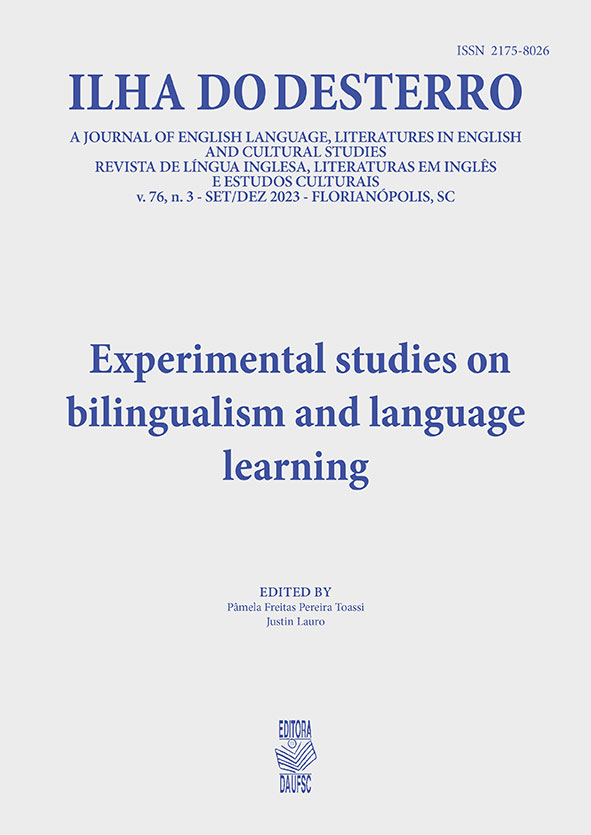The Processing of English caused-motion construction by EFL learners
DOI:
https://doi.org/10.5007/2175-8026.2023.e94720Palavras-chave:
Language processing, EFL learners, caused-motion constructions, acceptability judgement taskResumo
This article investigates the processing of English caused-motion constructions by Brazilian EFL learners. Drawing on corpus data on the production of such constructions by Brazilian learners, this study experimentally tests the four following constructional domains of caused motions discussed in Rosa (2020): (1) literal caused motions with instantiating verbs (e.g., put the toys into the box); (2) figurative caused motions with instantiating verbs (e.g., get yourself in trouble); (3) literal caused motions with modifying verbs (e.g., they laughed him out of the office); and (4) figurative caused motions with modifying verbs (e.g., she talked me into stupor). An acceptability judgment task with 120 EFL Brazilian learners at two levels of proficiency (B2 and C1) was devised so as to investigate the development of caused motions by testing two aspects and their effect on the comprehension of the structure: (1) level of proficiency, and (2) the degree of linguistic complexity of the structures in question. The results of the experimental study showed that learners’ proficiency level does affect their comprehension of the structures. However, the linguistic complexity of the structures seems to play an even greater role in that learners exhibit a descending level of comprehension of caused motions that is proportional with the ascending level of semantic and syntactic complexity of the structures.
Referências
Berber Sardinha, T. (2004). Linguística de Corpus. Barueri: SP: Manole.
Brezina, V. (2018). Statistics in Corpus Linguistics - A Practical Guide. Cambridge: Cambridge University Press.
Boas, H. C. (2013) Cognitive Construction Grammar. In T. Hoffmann, G. Trousdale (Ed.), The Oxford Handbook of Construction Grammar (Chapter 13, pp. 233 – 252). New York: Oxford University Press.
Cabrera, M., & Zubizarreta, M. L. (2004) Constructional properties versus lexical specific transfer: overgeneralized causatives in L2 English and L2 Spanish. BUCLD, 28 Proceedings Supllement.
Ellis, N. C. (2013). Second language acquisition. In T. Hoffmann, G. Trousdale (Ed.), The Oxford Handbook of Construction Grammar (Chapter 20, pp. 365 – 378). New York: Oxford University Press.
Fillmore, C., P. Kay, & M. O'Connor. (1988). Regularity and idiomaticity in grammatical constructions: the case of let alone. Language 64, pp. 501–538.
Gilquin, G. & Gries, S. (2009). Corpora and experimental methods: a state-of-the-art review. Corpus Linguistics and Linguistic Theory 5(1), pp. 1-26.
Goldberg, A. E. (1995). A Construction Grammar Approach to Argument Structure. Chicago: The University of Chicago Press.
Goldberg, A. E. & Jackendoff, R. (2003). The resultative as a family of constructions. Language 80, pp. 532–68.
Gries, S. Th. & Wulff, S. (2005). Do foreign language learners also have constructions? Evidence from priming, sorting, and corpora. Annual Review of Cognitive Linguistics 3, p. 182-200.
Keating, D & Jegerski, J. (2005) Experimental Designs in Sentence Processing Research: A Methodological Review and User's Guide. Studies in Second Language Acquisition, v37 n1, pp. 1-32.
Levin, B. and Rappaport Hovav, M. (1995). Unaccusativity: At the syntax-lexical semantics interface. Cambridge, MA: MIT Press.
Hampe, B. (2010). Metaphor, constructional ambiguity and the causative resultatives. In Handl, S. & Schmid, J. (Ed.) Windows to the mind: Metaphor, metonymy and conceptual blending. (pp. 185–215). Berlin & New York: Mouton de Gruyter.
Ionin, T., & Zyzik, E. (2014) Judgment and Interpretation Tasks in Second Language Research. Annual Review of Applied Linguistics, 34, pp. 37-64. doi:10.1017/S0267190514000026
Lindquist, H. (2009). Corpus Linguistics and the Description of English. Edinburgh: Edinburgh University Press.
McEnery, T. & Hardie, A. (2012). Corpus Linguistics. Cambridge: Cambridge University Press.
Rosa, R. G. (2020). Construções de movimento causado em um corpus de aprendizes de inglês: da observação à experimentação. [PhD dissertation, University of São Paulo].
Schütze, C. & Sprouse, J. (2014) Judgement Data. Research Methods in Linguistics. In Podesva, R. J. & Sharma, D. (Ed.) (Chapter 3, pp. 27-50). Cambridge: Cambridge University Press.
Sprouse, J. & Almeida, D. (2013). The empirical status of data in syntax: A reply to Gibson and Fedorenko. Language and Cognitive Processes, 28, pp. 222-228. doi: 10.1080/01690965.2012.703782.
Suzuki, K., Shioda, K., & Kikuchi, N., Maetsu, M. and Hirakawa, M. (2016). Cross-linguistic Effects in L2 Acquisition of Causative Constructions. BUCLD 40 Online Proceedings Supplement.
Downloads
Publicado
Edição
Seção
Licença
Copyright (c) 2023 Rodrigo Rosa

Este trabalho está licenciado sob uma licença Creative Commons Attribution 4.0 International License.
A revista Ilha do Desterro publica artigos e resenhas inéditos, referentes as áreas de Inglês, Literaturas em Língua Inglesa e Estudos Culturais. Publica volumes mistos e/ou temáticos, com artigos e resenhas em inglês e português.
Autores mantém os direitos autorais e concedem à revista o direito de primeira publicação, com o trabalho simultaneamente licenciado sob a Licença Creative Commons Attribution que permite o compartilhamento do trabalho com reconhecimento da autoria e publicação inicial nesta revista.

This work is licensed under a Creative Commons Attribution 4.0 International License.



